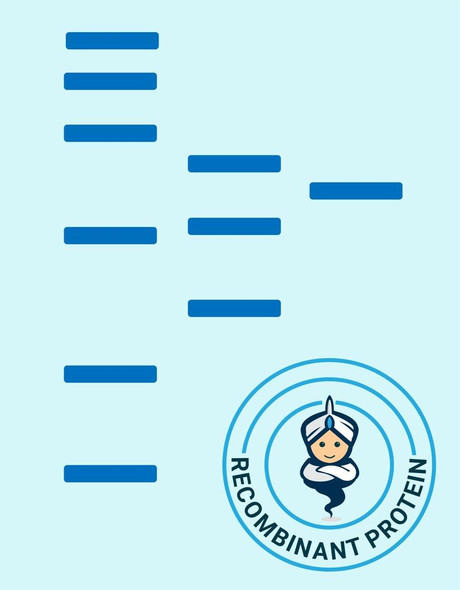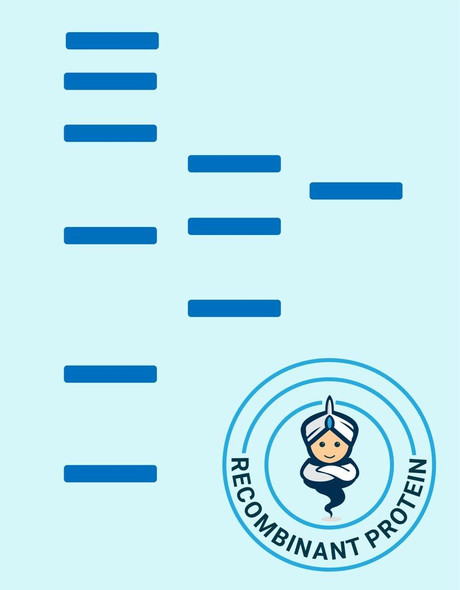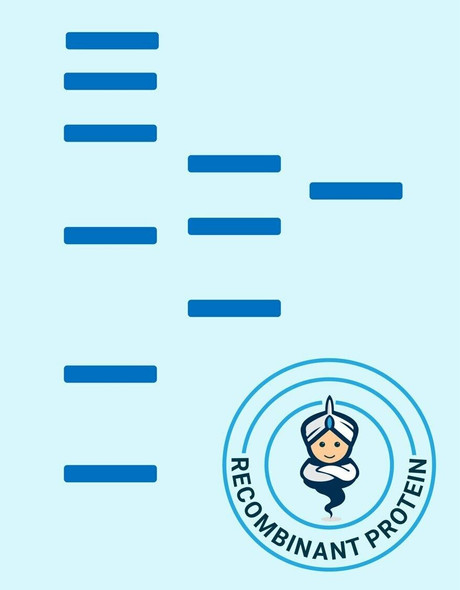Human IL 7 Recombinant Protein (RPPB0539)
- SKU:
- RPPB0539
- Product type:
- Recombinant Protein
- Size:
- 10ug
- Species:
- Human
- Target:
- IL 7
- Synonyms:
- Lymphopoietin 1 (LP-1)
- pre-B cell factor
- IL-7
- Source:
- Saccharomyces cerevisiae
- Uniprot:
- P13232
Description
| Product Name: | Human IL 7 Recombinant Protein |
| Product Code: | RPPB0539 |
| Size: | 10µg |
| Species: | Human |
| Target: | IL 7 |
| Synonyms: | Lymphopoietin 1 (LP-1), pre-B cell factor, IL-7. |
| Source: | Saccharomyces cerevisiae |
| Physical Appearance: | Sterile Filtered White lyophilized (freeze-dried) powder. |
| Formulation: | Lyophilized from a concentrated (1mg/ml) solution in water containing 20mM phosphate buffer. |
| Solubility: | It is recommended to reconstitute the lyophilized Interleukin -7 in sterile 18M?-cm H2O not less than 100µg/ml, which can then be further diluted to other aqueous solutions. |
| Stability: | Lyophilized Interleukin-7 although stable at room temperature for 3 weeks, should be stored desiccated below -18°C. Upon reconstitution IL7 should be stored at 4°C between 2-7 days and for future use below -18°C.For long term storage it is recommended to add a carrier protein (0.1% HSA or BSA).Please prevent freeze-thaw cycles. |
| Purity: | Greater than 98.0% as determined by SDS-PAGE. |
| Amino Acid Sequence: | The sequence of the first five N-terminal amino acids was determined and was found to be Asp-Cys-Asp-Ile-Glu |
| Biological Activity: | The ED50 as determined by the dose-dependent stimulation of thymidine uptake by murine pre-B cell line 2E8 is < 0.5 ng/ml, corresponding to a specific activity of > 2 x 106 units/mg. |
IL-7 is a cytokine important for B and T cell development. This cytokine and the hepatocyte growth factor (HGF) form a heterodimer that functions as a pre-pro-B cell growth-stimulating factor. This cytokine is found to be a cofactor for V(D)J rearrangement of the T cell receptor beta (TCRB) during early T cell development. This cytokine can be produced locally by intestinal epithelial and epithelial goblet cells, and may serve as a regulatory factor for intestinal mucosal lymphocytes. Knockout studies in mice suggested that this cytokine plays an essential role in lymphoid cell survival.
Interleukin-7 Human Recombinant produced in yeast is a single, glycosylated polypeptide chain containing 152 amino acids and having a molecular mass of 17.4 kDa. The IL-7 is purified by proprietary chromatographic techniques.
| UniProt Protein Function: | IL7: Hematopoietic growth factor capable of stimulating the proliferation of lymphoid progenitors. It is important for proliferation during certain stages of B-cell maturation. Belongs to the IL-7/IL-9 family. 2 isoforms of the human protein are produced by alternative splicing. |
| UniProt Protein Details: | Protein type:Apoptosis; Secreted, signal peptide; Cell development/differentiation; Cytokine; Secreted; Cell cycle regulation Chromosomal Location of Human Ortholog: 8q12-q13 Cellular Component: extracellular space; extracellular region Molecular Function:interleukin-7 receptor binding; protein binding; growth factor activity; cytokine activity Biological Process: positive regulation of organ growth; humoral immune response; T cell lineage commitment; organ morphogenesis; positive regulation of T cell differentiation; cell-cell signaling; regulation of gene expression; homeostasis of number of cells within a tissue; negative regulation of catalytic activity; positive regulation of cell proliferation; positive regulation of B cell proliferation; negative regulation of apoptosis; bone resorption |
| NCBI Summary: | The protein encoded by this gene is a cytokine important for B and T cell development. This cytokine and the hepatocyte growth factor (HGF) form a heterodimer that functions as a pre-pro-B cell growth-stimulating factor. This cytokine is found to be a cofactor for V(D)J rearrangement of the T cell receptor beta (TCRB) during early T cell development. This cytokine can be produced locally by intestinal epithelial and epithelial goblet cells, and may serve as a regulatory factor for intestinal mucosal lymphocytes. Knockout studies in mice suggested that this cytokine plays an essential role in lymphoid cell survival. Alternative splicing results in multiple transcript variants encoding distinct isoforms. Additional splice variants have been described but their presence in normal tissues has not been confirmed.[provided by RefSeq, Dec 2010] |
| UniProt Code: | P13232 |
| NCBI GenInfo Identifier: | 124354 |
| NCBI Gene ID: | 3574 |
| NCBI Accession: | P13232.1 |
| UniProt Secondary Accession: | P13232,Q5FBY5, Q5FBY9, A0N0L3, |
| UniProt Related Accession: | P13232 |
| Molecular Weight: | 177 |
| NCBI Full Name: | Interleukin-7 |
| NCBI Synonym Full Names: | interleukin 7 |
| NCBI Official Symbol: | IL7 |
| NCBI Official Synonym Symbols: | IL-7 |
| NCBI Protein Information: | interleukin-7 |
| UniProt Protein Name: | Interleukin-7 |
| Protein Family: | Interleukin |
| UniProt Gene Name: | IL7 |
| UniProt Entry Name: | IL7_HUMAN |










